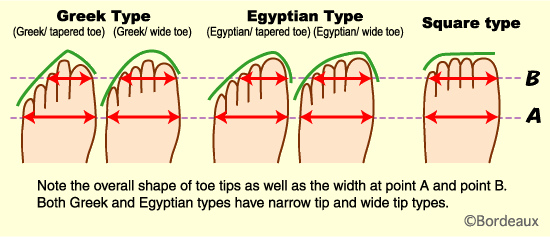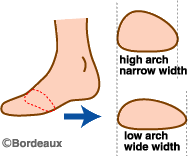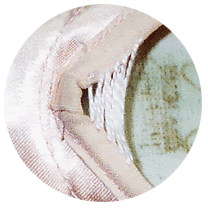Here’s are regular ballet slippers/flats, versus pointe shoes.

-

See the difference? The pointe shoes, on the right are much harder all-around, which allows the dancer to stand on his/her
toes.
The Anatomy of the Pointe Shoe:

(1) platform of tip (2) edge of pleats or feathers (3) outer sole (4) waist seam (5) quarter or heel section (6)vamp:
top of the box that covers the toes (vamp length is the distance between the drawstring knot and the top edge of the box.
Some European manufacturers refer to vamp length as the distance between the drawstring knot and the edge of the pleats or
feathers) (7) pleats or feather: an area underneath the box where the satin is pleated to fit under the sole (8) wings or
supports (9) shank or narrow supporting spine: attatched to the back of the insole (10) stiffened box or block: made of layers
of glue and fabric surrounding the toes and ball of the foot (11) drawstring knot (12) drawstring casing: piece of bias tape
stitched around the edge of the shoe to contain the drawstring (13) insole (14) back seam: divides the quarters
Pointe
Shoes Cannot Be Worn Right Right Away!Pointe shoes must be ‘broken in’ before proper wearing. If you are
a beginner, do NOT try to break in shoes without the teacher’s proper instructions! The box of the pointe shoe needs
to be squashed a little bit, in order for it to mold to your foot. Some people step on the box, while some put it in a door
hinge. *warning*-stepping on the box/smushing it in a door hinge may permanently damage your shoes! Unless you are more experienced
or have your teacher’s permission, I do not recommend this method as it may make your shoe become a very weird shape
and break in all the weird places. The shank comes in 3 strengths-soft, medium, or hard. It is necessary to bend the shanks
a bit…not in the center, but closer to the hell where your arch is, so it will be easier to wear. The best way to break
in pointe shoes is to do light barre work and wear them around your house(not going on pointe, just wearing them like regular
shoes) The sweat in your feet will moisten the pointe shoe and help it conform to your foot.
OMG I WANT TO GO ON
POINTE!Ballet students shouldn’t go on to pointe before the age of 11 or 12, because the bones are properly
developed and these students usually do not have enough strength until this age. Pointe work usually shouldn’t begin
until the student has had at least 2-3 years of ballet training. Yet, some students may not go on pointe until 8 years of
ballet training, while others go on pointe after 2 months of training. Sounds crazy, I know. But it’s true!
10
reasons why teachers do not put students on pointe1. Improper placement
2. Too young
3. Not pulled up in body
or feet
4. Feet not arched enough
5. Overweight
6. Lack of strength in torso
7. Weak knees
8. Weak ankles
9. Basic stance on demi-pointe not strong and correct
10. Taking too few classes per week
I’m desperate-can
I teach myself pointe?Please please PLEASE do not try to teach yourself pointe! This is very dangerous and you are
very very very susceptible to damage your feet, break bones, and injure yourself. If your teacher has not allowed you on pointe,
it is probably because you do not have enough strength, technique, etc.
Buying your pointe shoesIt's very important
to buy your pointe shoes at a dance store where there are people who know a lot about the shoes and how they should fit. Each
pair is slightly different because they are handmade, so even within a particular style there could be variations. Always
have the type of toe padding you will be using with you because some are more bulky than others and it can affect the fit.
A shoe should not be baggy when standing flat. There may be slight gaps when on pointe, but nothing major. A good way to know
if the length is right is to stand in second position (flat) and grande plie. Your toes should just touch the front of the
box. It is no fun dancing in pointe shoes that are too short. The shoe digs into your heel and it's very painful to roll through.
A shoe that is too big is also bad, because when you go on pointe, your foot slides down into the box, which can cause a lot
of foot problems. The heel also slips off when you dance. If you go to the right store, I'm sure you'll get a good fit.
Types
of feetNow, since pointe shoes are made for different types of feet, take a look at the picture:

There are different types of toes-tapered, round, or square. so here is a fit-guide:
Fit Guide
Categories of Foot TypeThere are mainly
three types of feet.
Greek type Foot with the second toe being the longest.
Egyptian type Foot with
the big (first) toe being the longest.
Square type Foot with even length toes.
It is generally believed that
"Egyptian" is wider at forefoot (or simply "wide") and "Greek" is narrow at forefoot (or simply "narrow"). There are, however,
"wide" and "narrow" forefoot types for both "Egyptian" and "Greek" foot types
PIC 1

*When choosing pointe shoes, different shoes will be recommended depending on the difference of foot width at point
A and point B in the diagram above.
____
Categories or Pointe Shoe BoxBox shape of pointe shoes
can be divided into 4 types. There are dancers who change the shape of the box by stepping onto it and flattening it. This
method only affects the "box" part of the shoe and your platform shape will remain unchanged. There is a limit to how much
adjustment you can achieve by such means as described above. It is wise to put your foot shape into consideration when choosing
your shoes -- not just size and width.
PIC2

____
Pointe Shoes Quick Fit ChartThis chart below shows various pointe shoes, categorized
by box shapes.
Vertical Axis = Platform and box shape (The higher on the axis, the rounder the shape.
The
lower you go on the axis, the flatter the shape of the box/platform).
Horizontal Axis = Box shape viewed from above
(The left is tapered, the right side is square).
PIC 3
 Notes
Notes-The chart uses "box shape" for categorizing the shoes. It does not reflect different widths within
the same model. Please note that the width (or shape) of platform is not the same as "width" of a shoe.
-The chart is
based on a comparison of box shapes as viewed from above and not based on my personal feel of shoes upon wearing.
____
Tips & Suggestions*If you have Egyptian type
feet ...* If your big and second toes, or the first three
toes are about the same length=-Medium to wide platform is recommended.
If you have high arch -- pale yellow to green zone (of pic 2)
If you have low arch -- pale pink to blue zone (of pic 2)
* If your big toe is notably longer than the rest=-This foot shape is probably the least "symmetrical"
which is what pointe shoes are. If the box is too taper, it will not accommodate the long big toe. And if the box is too square,
the result will be too much space for all the toes except for the big toe, which will make dancing difficult. You may want
to choose a square shaped box in order to keep the big toe straight in the shoe. However, considering the weight load of the
big toe, you might want to choose medium or moderate shape box.
*If
you have Greek type feet ...* And if your second toe is the
longest=-Moderate (medium) to narrow (tapered) platform is recommended.
If you have high arch -- yellow zone (of pic 2)
If
you have low arch -- pink zone (of pic 2)
(Within each zone, choose wide shoes if your foot is wide. Choose
narrow shoes if your foot is narrow.)
-Be careful not to choose platform that is too wide and square even if your foot
is wide. The long second toe may bear unnecessary weight load and pain may result.
* If your first 2 or 3 toes are about the same length-Some Greek type may have almost even length
toes.
-Medium (moderate) to wide platform is recommended for this type.
If
you have high arch -- pale yellow to green zone (of pic 2)
If
you have low arch -- pale pink to blue zone (of pic 2)
Greek type foot with even length toes usually don't taper
that much toward the tips, so pointe shoes with too much of a tapered box may cause tightness at the tips of the toes.
*If you have Square type feet ...*If your arch is high=-Regardless of your width, shoes in the green zone are recommended for
best fit. (of pic 2)
-If you have wide foot -- "wide" models within the green zone (of pic 2)
-If you have narrow foot
-- "narrow" models within the green zone (of pic 2)
*If your arch
is low=-Regardless of your width, shoes in the blue zone are recommended for best fit. (of pic 2)
-If you have
wide foot -- "wide" models within the blue zone (of pic 2)
-If you have narrow foot -- "narrow" models within the blue
zone (of pic 2)
(Tapered box shoes will result in pain in the big toe and the little toe even if your foot width is
quite narrow when you have square foot)
*Even if the widths are the
same ...Same size and same width can still be divided into "high arch with narrow width" and "low arch with
wider width".
PIC 4
 If you have high arch
If you have high arch -- Regardless of width, yellow or
green zone (of pic 2)
If you have low arch -- Regardless of width,
pink or blue zone (of pic 2)
*When what you see is NOT what you get
...There are shoes that look square when viewed from outside, but with "inside" shape that is tapered. Please
be aware of this when choosing your pointe shoes. This type of shoe is great if you have tapered feet but like to wear pointe
shoes with wide platforms. If your big toe is notably longer, however, pain may result from pressure on the big toe nail.
By the same token, there are shoes that look tapered, but actually have wide "inside".
For example, model D by Russian-Class
has more room inside the shoe than appears on the outside. Always check the inside of the shoes when possible.
PIC
5
 Methods To Enhance The Fit Of Your Pointe ShoesStitching
the VampRecommended when:
Methods To Enhance The Fit Of Your Pointe ShoesStitching
the VampRecommended when:*The width of the shoes
is just slightly too wide. (There is a limit to how much adjustment you can achieve with this method. If the shoe is not a
close fit to begin with, do not try this or any other method.)
*The shoe is not too loose, but you want the fit to be a
little more snug and secure.
* To prevent flexible arches from popping out or knuckling over.
* To help prevent hallux
valgus.
*One toe is notably longer than the rest. (Your foot will be more evenly supported and it will ease the weight
bearing on the long toe.)
How to:-Use thread (such as
embroidery threads) and stitch up the opening of the shoe at the vamp. I always make sure to pierce the needle through from
above and stitch along in a Pic 6. This prevents the threads from bunching up in a ring. But there is no set way of doing
this. (The photo is a close up of the shoe opening.)
PIC 6
 Wetting With Water MothodRecommended for:
Wetting With Water MothodRecommended for:*
Dancers with narrow feet who have a hard time finding shoes that fit well. (It is possible to reduce the width of the shoe
from D to C, or C to B and so on. However, reducing the width by two letters such as from D to B, cannot be done. When the
shoes are simply too loose, this or no other method will work. There is a limit to how much adjustment can be made.)
*
When you mistakenly ordered the wrong width of shoes .
* When the shoes don't quite conform to your foot shape.
How to:1. If you need to lower your crown, do what you need to do (stepping
on it, etc.) to achieve it before you proceed to wet your shoe.
2. To prevent the platform of the shoe from getting wet,
stuff newspaper or other material to protect it. (Once wet, platforms can change size in terms of length and width.)
3.
With a spray bottle, spray a fine mist of water to wet the box area from outside and from inside.
4. To make the shoe conform
to your foot shape, wear the shoe and dry it a little with a hair dryer.
5. When it is half way dry, take the shoe off
from your foot and let it air dry the rest of the way.
Note* This method sometimes creates watermarks on the satin
of your shoes, depending on the brands. Also, it sometimes dull the sheen of the satin. Take care not to over wet the shoe
and over shrink it. The degree of shrinkage also varies depending on brands. Take your time and proceed with caution. Wet
and shrink gradually by repeating the process as necessary. Satin material usually hardens after wetting and drying, so you
may want to soften the fabric by massaging with your fingers. This method works with not only new shoes but old shoes that
have been worn, but once you have varnished your shoes, there can be no shrinkage.
Preparing for Pointe WorkTo
be successful on pointe, it is important to have strong ankles. I suggest doing an exercise my ballet teacher has my class
do everyday: Standing in first position, do 16 relevés (begin and end in plie) and then 16 elevés (begin and end with straight
legs). Next, standing on your right foot, coupe you left foot in back. Keeping this position do 8 relevés and then 8 elevés.
Repeat on the left foot. Try not to do them too fast, or else you will start to build endurance, not strength. It may be hard
at first to get through, but after a while it gets easier and soon you will be able to do the whole thing twice through! This
has really strengthened my feet and ankles this year, improving not only my pointe work, but also my arabesques and turns.
Being
‘en pointeAlways remember, that your toes are not made to support your weight in the pointe position. You need
to support this weight by pulling up and out of your shoes with the rest of your body. Always keep your knees straight and
pulled up. Keep your back straight and pulled up also. Your chest should be lifted and slighlty forward (remember...shoulders
down) Your lower back does a lot of the supporting. By holding the muscles in your legs, butt, and back, you can make pointe
a whole lot easier on yourself. Also, something my teacher says a lot, "When you are on going up onto pointe push at where
the ribbons cross". This helps to keep your feet from rolling in or out on pointe, which is very dangerous! It also helps
you achieve a better pointe.
Pointe Shoe PaddingA lot of dancers use padding to help the pain of pointe.
The tradicional padding is lambswool, it is very soft, but thin. Some dancers use gel pads, ouch pouches, jelly toes, etc.
If you do not want to spend money buying toe pads, I suggest using a layer of paper towel over each foot, and some masking
tape in place of toe tape. Socks, cotton balls, sponges, bubble wrap, bandaids, etc are also commonly used.
When to
Buy New Pointe Shoes-gradually feeling loss of support
-boxes/ shank soft, easy to push/bend with fingers
-harder
to stay stable on pointe
-ask teacher if she thinks pointes are dead



